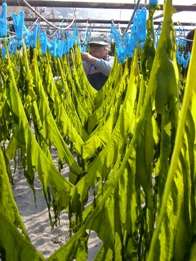As marine pollution continues to rise, various interesting solutions have been proposed to remove toxic contaminants.
Various species of seaweed are able to extract toxic compounds from seawater, says Shinichi Nagata of the Environmental Biochemistry Group, at Kobe University, Japan, and colleagues at Shimane University and Nankai University, China.
They point to the brown seaweed, Undaria pinnatifida, known as wakame in Japan, and note that it has been the focus of research in this area for almost a decade.

Wakame can thrive evening the presence of carbon, ammonium, nitrate and phosphate in sea water that would otherwise be lifeless so it would be perfect as a pollution control but there remains an issue of disposal after it has consumed organic and inorganic pollutants in seawater.
Organic pollutants are absorbed by cultured wakame so cultivated wakame has to be considered toxic waste rather than a useful byproduct of marine bioremediation. If it were not toxic waste, disposal would be simple - composting. Natural wakame has been used as a fertilizer since ancient times, they explain, so the composting process could be an effective means of degrading wakame into a useful form and so recycling organic substances containing C, N and P from coastal waters.
Now there's hope. The team has found a highly efficient way to accelerate the composting process in the form of a novel marine bacterium, identified as a Halomonas species and given the label AW4.
Partial DNA analysis helped identify the active species isolated from the seaweeds in Awaji Island, Japan. The researchers explain that strain AW4 grows well even at high salt (sodium chloride) concentrations and can reduce the total organic components, including pollutant content, of the seaweed significantly within a week.
Article: Disposal of seaweed wakame (Undaria pinnatifida) in composting process by marine bacterium Halomonas sp. AW4 by Nagate et al in International Journal of Biotechnology, 2008, 10, 73-85





Comments